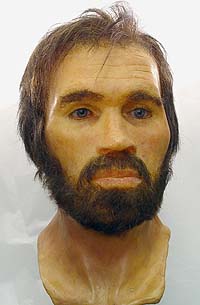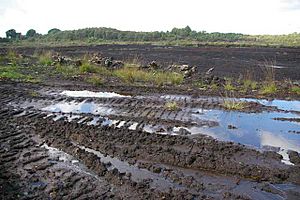Lindow Man facts for kids
Lindow Man is a very old, well-preserved body found in a bog (a type of wet, spongy ground) in Lindow Moss, England. He was discovered on August 1, 1984, by people cutting peat (decayed plant material) for fuel. This amazing find was called "one of the most important archaeological discoveries of the 1980s."
When he died, Lindow Man was a healthy young man in his mid-20s. Scientists think he might have been important because his body doesn't show signs of hard physical work. He died sometime between 2 BC and 119 AD, either during the Iron Age or the Romano-British period.
The body of Lindow Man has been carefully preserved using a method called freeze-drying. You can see him on display at the British Museum in London. Sometimes, he travels to other museums, like the Manchester Museum.
Contents
What is Lindow Moss?
Lindow Moss is a peat bog located in Wilmslow, Cheshire, England. People have used this land for a long time, even since the medieval period. The bog formed after the last ice age in hollows left by melting ice.
This bog used to be very large, covering about 600 hectares (1,500 acres). Today, it is much smaller, only about a tenth of its original size. For hundreds of years, people dug up peat from the bog to use as fuel. This continued until the 1980s.
The Discovery of Lindow Man
Lindow Man was found on August 1, 1984. He was discovered by Andy Mould, one of the peat workers. This was about a year after another body, known as Lindow Woman, was found nearby.
The landowners gave Lindow Man's body to the British Museum. On August 21, 1984, he was moved to London for study and display. At first, some people jokingly called him "Pete Marsh" or "Pete Bogg."
News of the discovery was shared with the public very quickly. Lindow Man was the best-preserved bog body ever found in Britain. His discovery created a lot of excitement in the country and around the world. Many archaeologists had hoped to find such a body. A TV show about Lindow Man in 1985 was watched by 10 million people.
Studying Lindow Man's Body
Lindow Man was the first well-preserved bog body found in Britain. His condition was similar to other famous bog bodies like Grauballe Man and Tollund Man from Denmark.
Scientists learned a lot about Lindow Man from his remains. He was about 5 feet 6 inches to 5 feet 8 inches (1.68 to 1.73 meters) tall. He weighed around 132 pounds (60 kg). He was in his mid-20s when he died.
His body still had a trimmed beard, moustache, and sideburns of brown hair. He also had healthy teeth and neat fingernails. This suggests he did not do much heavy or rough work.
Scientists also studied Lindow Man's last meal, which was still in his stomach. They found that he mostly ate cereals. Some mistletoe pollen was also found, which means he likely died in March or April.
Lindow Man's body is now kept at the British Museum. Some people from North West England wanted the body to stay in Manchester. There have also been discussions about whether displaying the body is respectful to the dead.
Images for kids
See also
 In Spanish: Hombre de Lindow para niños
In Spanish: Hombre de Lindow para niños




